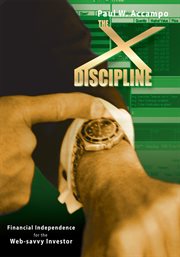Nonfiction
eBook
Details
PUBLISHED
Made available through hoopla
DESCRIPTION
1 online resource
ISBN/ISSN
LANGUAGE
NOTES
When was the last time your broker called to tell you to sell? During the 32-month bear market between March 2000 and March 2003, buy and hold advice from brokers and financial advisors failed to stem portfolio losses ranging from 40 to 80%. People lost money for one reason: they failed to sell. There's no safe haven where you can buy a stock and forget about it. Have you lost faith in the individuals and institutions that recommended your investments? Are you looking for a better way? This rare, realistic book offers a, unique, practical alternative depending on others for advice and to the risks, effort, and time involved in managing a stock portfolio yourself. This book is specific - instead of the usual bland list, the author escorts you into the internals of websites with down-to-the-mouseclick procedures for extracting what you need to make clear-cut decisions. He helps you build two essential (but usually omitted) skills for investing: how to critically read the news and control your emotions. His disciplined approach to selling works under all economic conditions to protect you against market downturns; yet, the search that yields high-performing low-volatility funds requires only moderately frequent trading and only about one hour a week of your time. The method frees you from the brokers and financial advisors who have not the skills, methods, or incentive to tell you when to sell - and eliminates their exorbitant fees. With numerous examples and detailed guidance, The X-Discipline shows you how to anticipate market moves by understanding the impact of news events. It helps you resist the temptation to react emotionally when the market gets volatile or turns against you. No longer dependent on others' advice, you can use ultra-discount brokers to trade low cost efficiently-run funds. Synopsis of the Book The X-Discipline is organized into four Parts that let you to use it in different ways. If you want to sit down and surf your way through the steps, start with Chapter 1 and work through to Chapter 7. Your first session will take two to three hours, during which you will find the dogs in your portfolio and build a list of potential winners. With repetition, running through the five steps will require only a few minutes weekly. Because it focuses on process, Part 1 is light on explanation. Each Part 1 chapter has a Part 2 counterpart that goes into greater detail on the origin and reasoning behind the strategy and on potential problems. You can read Part 2 sequentially or use it as a reference. If you want to learn about The X-Discipline before adopting it, begin with Chapter 8 in Part 2. Part 3 has additional studies and time saving information, and Part 4 gives specific procedures for accessing websites. Updates to Part 4, which will change as websites change, are available on www. x-discipline. com Part 1: Immediate Results! Chapter 1: Charting Basics describes the use of charts to identify and measure trends, applying a technique used by experienced traders to identify trend reversals, which are key buy or sell signals. Chapter 2/Step 1: Determine the Market Stage helps you use the trend of the NASDAQ Composite Index to determine the Stage of the market, which helps you decide how much of your capital to put at risk. Chapter 3/Step 2a: Finding Mutual and ETF Winners introduces fund screeners, for exchange-traded and mutual funds. These online applications produce a list of the best performing funds during the most recent one to three months. Chapter 4/Step 2b&c: Selecting the Best of the Best shows you how to use the relative strength chart application to trade off high performance and low volatility, and how to eliminate mutual funds having undesirable attributes. Chapter 5/Step 3: Sell - Before You Buy describes planning your exit strategy, detecting failing performance and deciding whether when to sell. Chapter 6/Step 4: Review the News. News moves prices, and more of your decis
Mode of access: World Wide Web







